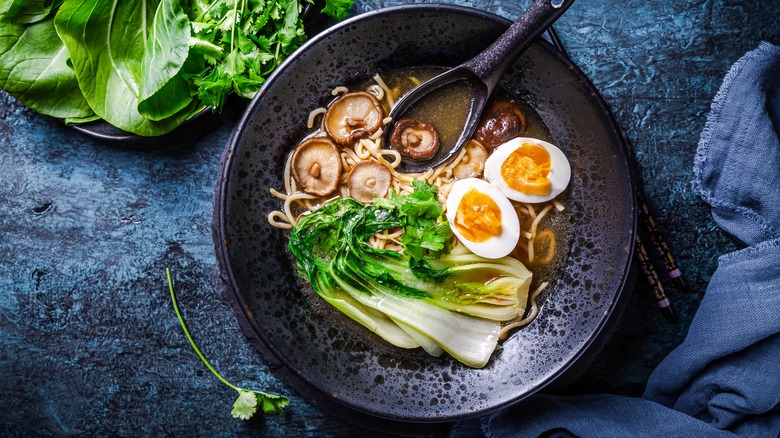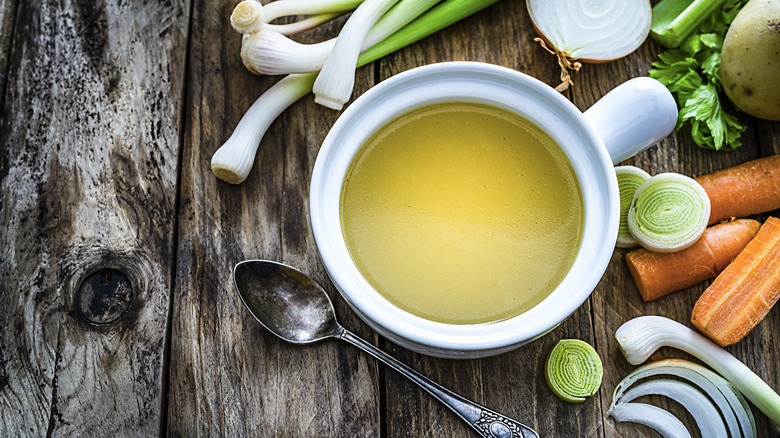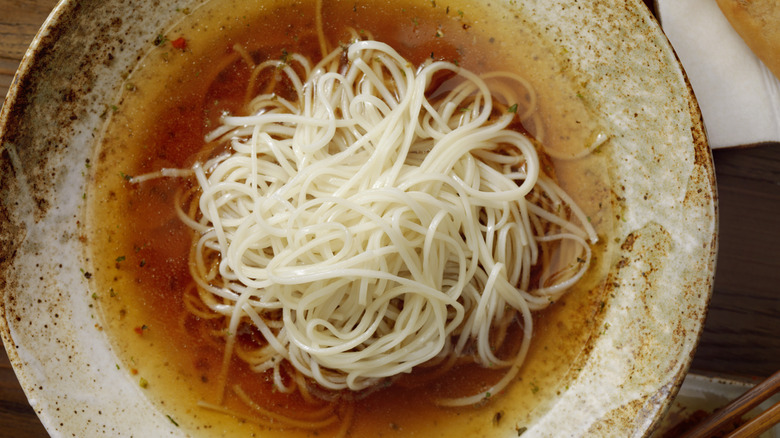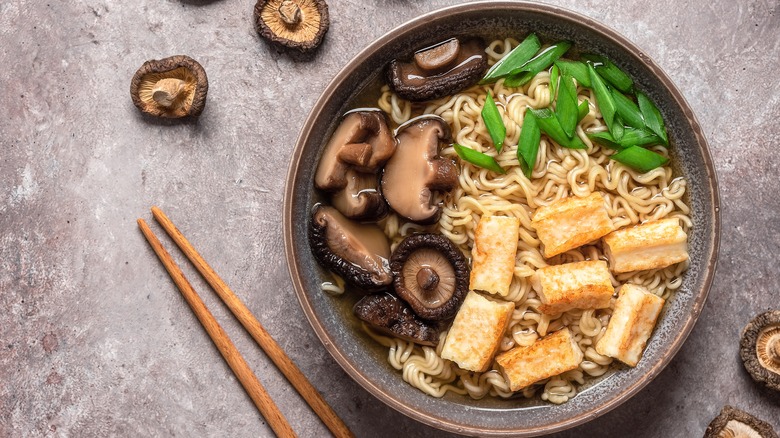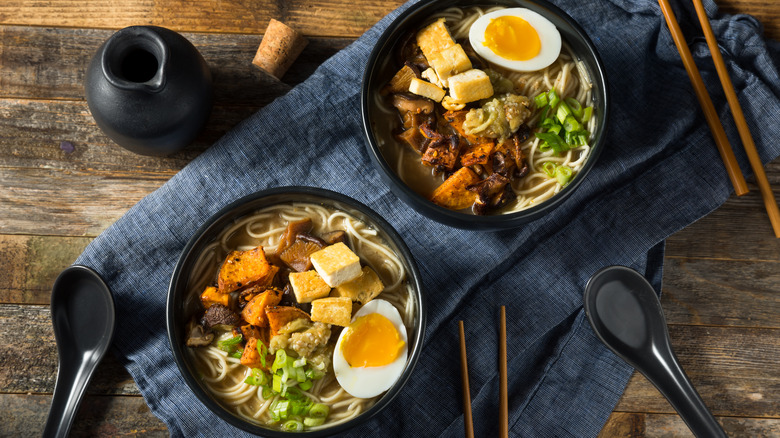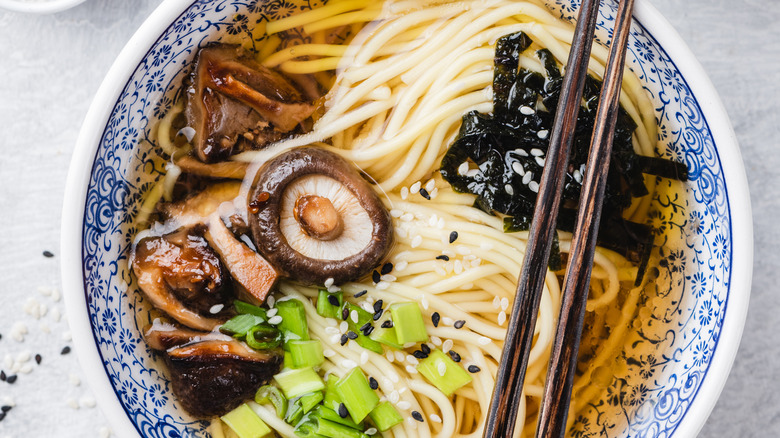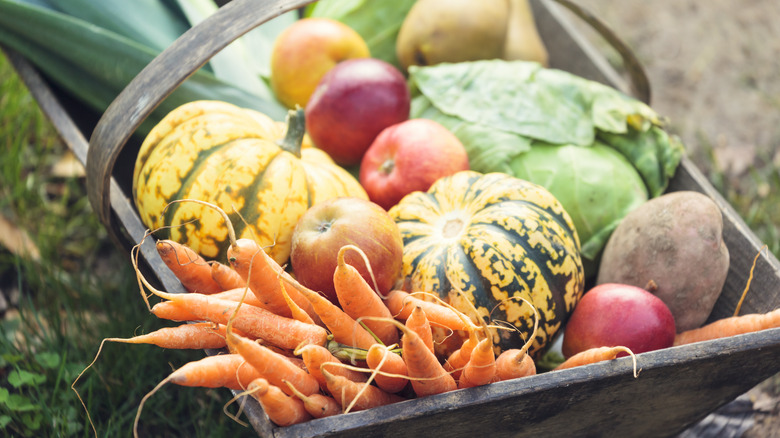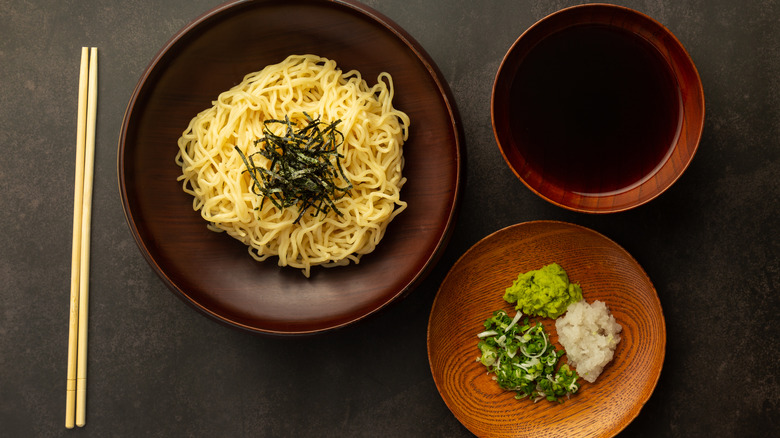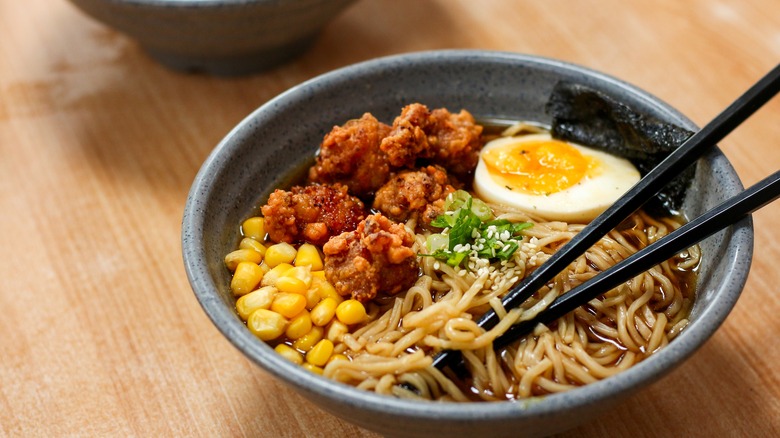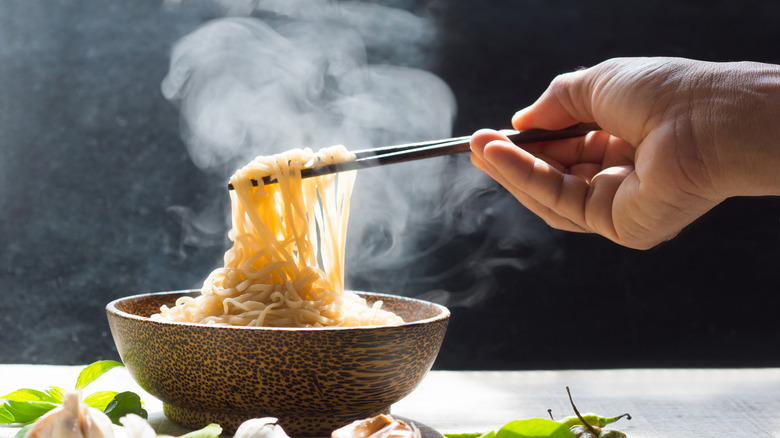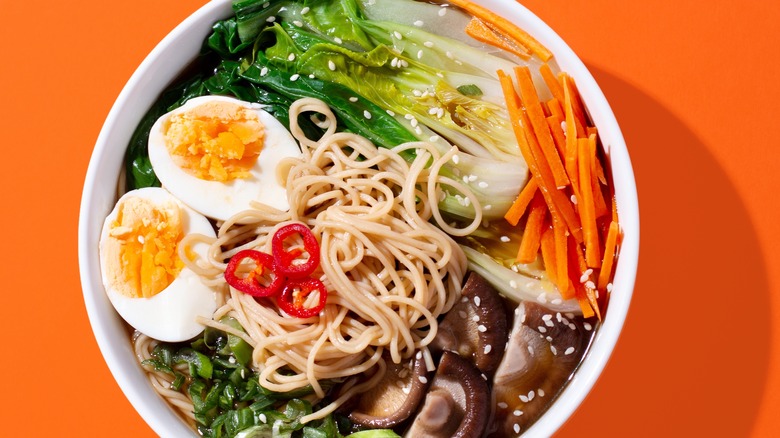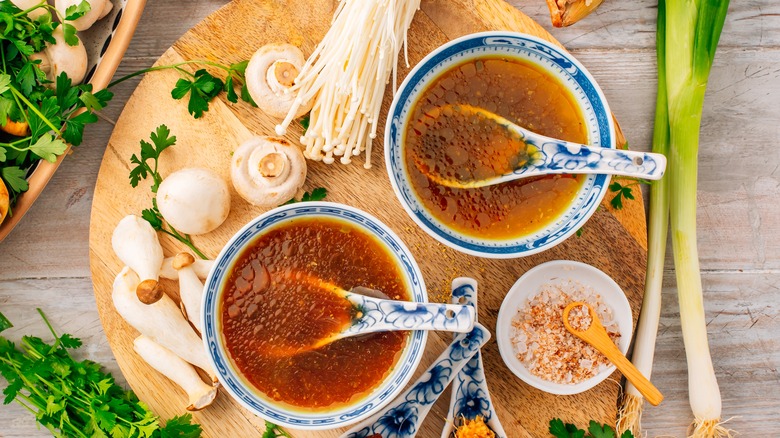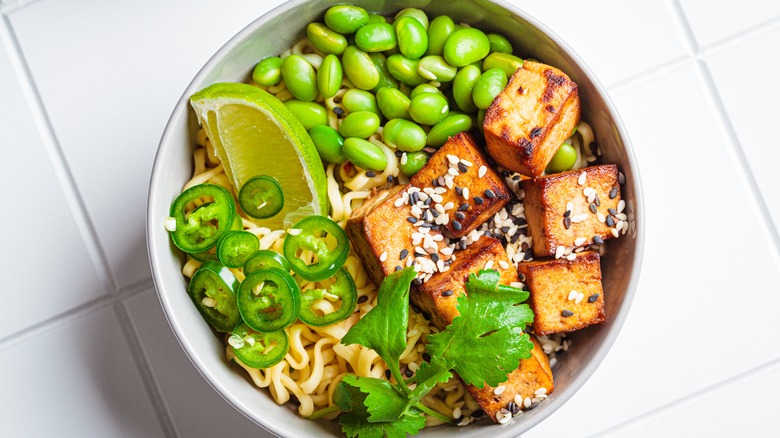12 Tips You Need To Know For Making Vegetarian Ramen
The first time I ever tried vegetarian ramen at a restaurant was a huge letdown. The broth was almost flavorless, the toppings were limited, and there was no variety in the dish's texture. Worst of all, there was only one vegetarian ramen menu option — and, since non-vegetarian ramen is all made with bone or meat broths, there was no hope of asking for a different dish without the toppings.
This pushed me to research vegetarian ramen myself — the only way to truly satisfy my authentic vegetarian ramen craving. This is how I first came across the recipe book "Bowl". The book features vegetarian recipes for rice bowls, pho, and, of course, ramen — on top of information about buying ingredients, sourcing fresh noodles, and making homemade toppings.
"Bowl" was the first time I'd made a vegetarian ramen I actually thought was even better than its non-veg counterpart — and it was also better than the ramen I'd tried at local restaurants. The author, Lukas Volger, is hailed as an expert on all different kinds of vegetarian foods — his many recipe books, extensive culinary experience, his newsletter, and very own brand of veggie burgers are a testament to that. To really learn everything I could about vegetarian ramen, I knew I had to reach out to Volger. In this article, you'll find advice on making vegetarian ramen that includes exclusive tips from Volger.
Flavoring the broth: The base
There are a myriad of kinds of vegetarian broth bases that feature all different sorts of flavors, perfect for replicating the taste of a traditional meat-based ramen. Volger usually starts with a dashi or vegetable broth base for the best flavor. Dashi is a Japanese soup stock that makes it easy to achieve bold, rich flavor without using tons of ingredients. Vegetable broth is a similar alternative that provides a well-seasoned broth base for you to work with.
One of the most common ways to flavor vegetarian ramen is by using miso. If you've ordered vegetarian ramen at a restaurant before, you might be familiar with the flavor profile. It's umami and lightly salty, providing complexity to the broth that otherwise would not have much flavor.
There are three different kinds of miso you can add to your broth: white for light sweetness, yellow for a traditional ramen broth, and red for a bit more richness. Volger recommends mixing miso into a dashi or vegetable broth to achieve the complex, layered flavor that typically comes with meat-based ramen broths.
Flavoring the broth: Adding ingredients
When it comes to ramen broth, you should not stop after adding miso. Volger typically mixes other ingredients into his ramen broth to provide it with even more flavor, similar to how a ramen with meat or bone broth would. Scallions and grated ginger are two of his top recommendations — scallions will provide a lightly spicy flavor while grated ginger adds warmth.
Depending on the recipe you're following, you may notice that shiitake mushrooms are a common ingredient when it comes to making vegetarian ramen. Some recipes will call for fresh mushrooms, others for dried — either way, shiitake mushrooms will often be the key component to creating a broth that really tastes like non-vegetarian ramen. They add the same kind of rich, well-rounded flavor that comes with using dashi stock. If you are not a fan of the texture, you can boil them in the broth whole and remove them just before serving.
Protein substitutes for ramen dishes
If you're vegetarian, you are probably already used to substituting tofu for most meats, especially when it comes to ramen. Ramen dishes classically use steamed tofu, so it is nice and soft when incorporated into a ramen dish. But you do not need to be afraid of using baked or fried tofu, either — these are less traditional ways of preparing "meat" for a ramen dish.
The most intriguing element of ramen meat substitutes is always when they come with a little flavor of their own. Steamed tofu is lovely for texture and protein, but it only soaks up the flavor of the broth without providing its own. The best dish of vegetarian ramen I ever ate at a restaurant used a large piece of aburaage — fried, marinated tofu skin that tastes slightly sweet — in place of meat, and it added so much new flavor and texture to the dish.
You may also want to consider other protein alternatives when it comes to creative ramen recipes. Lighter ramen dishes may benefit from adding fresh edamame as a main source of protein. Tempeh is another alternative that typically comes with a more solid texture and nuttier flavor — like tofu, you'll be able to find smoky or flavored tempeh to use in your ramen, too.
Using texture in toppings
As a ramen expert, Volger knows that texture is one of the most important elements of a good ramen dish — and that it should not be left out of any vegetarian ramen dish. That doesn't just mean that you should include a single texture and leave it at that, though. Ramen relies on a wide range of textures that are all present in a single dish. "Textural variety is so important and you want to hit all the notes," Volger says. "There's a rich mouthfeel in the egg, crunchiness in fried garlic or frizzled shallots, and vegetables that bring their own characteristics."
Volger also highlights the importance of using seasonal toppings — something his book "Bowl" does with incredible ingenuity. He believes that playing around with seasonal ingredients is one of the best ways to achieve textural elements. "I really love the opportunity for seasonality in homemade vegetarian ramen, and that comes through in the texture... juicy ripe tomatoes, snappy spring peas, tender caramelized winter squash," he adds. When creating your own ramen dish, consider trying to find individual elements that each achieve a texture: soft, chewy, crunchy, juicy.
Essential vegetarian ramen toppings
When you think of a bowl of ramen, you probably picture certain traditional toppings. To most people, ramen comes with a type of meat, a soft-boiled ramen egg (often cut in half for visual effect), a fish cake, bean sprouts, and kombu (seaweed). Many of these elements are there not just for texture and taste, but also to make the dish look visually appealing. One of the best parts of "Bowl" is the photography — Volger's dishes look better than the ramen you'd find at a restaurant, and they're not impossible to replicate, either.
Volger highly recommends using the traditional soft-boiled egg when it comes to ramen toppings. You can even marinate your eggs in soy sauce to create a classic ramen egg. "I love to use things like chili oil, spice blends, and crunchy toppings like crispy-fried shallots as garnishes, too," adds Volger.
These elements can add extra flavor and customization to a ramen bowl. When you are looking at ramen toppings, you can consider ingredients that might vary based on individual preferences. If you are worried about adding too much spice to the communal ramen broth, for example, Volger's recommendation of chili oil and spice blends works just as well as a topping as it would in the broth itself.
Seasonality in vegetarian ramen
Ramen toppings shouldn't stop at just the classics. Volger again works with the seasons to find toppings that will elevate any ramen dish. "In general I see vegetarian ramen as a fun opportunity to incorporate the seasons... so in the late spring, asparagus is a favorite addition; in the summer, corn, tomatoes, basil," Volger says.
With you're purchasing ramen at a restaurant, it can be rare to find vegetarian dishes that change with the seasons; most restaurants will opt for one or two vegetarian staples that are never swapped out. This leaves home cooks with the opportunity to upgrade their vegetarian even more by opting for seasonal produce. "Bowl" features dishes for each season alongside classic year-round dishes, so it's easy to test out a wide variety of ramen dishes that can always feature fresh produce. "Right now I'm excited for my Summer Ramen, because I'm in the mood for summer," Volger says regarding his favorite ramen recipes from "Bowl." "It's a juicy bowl, sweet with corn and tomatoes and fragrant with basil."
Seasonal ramen styles
Did you know that the style of ramen dish you're making can also vary by season? Just as Volger allows seasonal produce to help dictate what flavors and textures he includes in his ramen, you can allow the weather to help you decide what kind of vegetarian ramen is best to make. This extends to more than just seasonal ingredients — some ramen dishes are designed to be consumed when the weather is too hot for a steaming bowl of broth.
One example of a seasonal ramen dish is Tsukemen ramen — or dipping ramen — a kind of ramen typically consumed in the summertime, because it is less of a warm dish than traditional ramen. This style of ramen involves making a much richer, more flavorful broth than you'd typically find in a normal ramen recipe. Instead of drinking the broth alongside the noodles, the ramen noodles are dipped into the broth before being eaten. The noodles are typically served cold or lukewarm, making them perfect to enjoy in the spring or summer.
Hiyashi Chuka (cold summer ramen) is another alternative to traditional ramen that you might find easier to eat in the heat. The entire dish of ramen is served cold, making it a seasonal staple when the weather is too hot to eat warm dishes. By combining seasonal dishes with Volger's tips for utilizing seasonal produce to add fresh flavor, it is easy to elevate your ramen dish by season.
Vegetarian alternative to common meat-based ramens
There are four types of ramen that are the most common kinds you would typically find at any ramen restaurant. These include shoyu, shio, miso, and tonkotsu. Miso ramen doesn't require much effort to make vegetarian (you'll find it's almost always the only broth option when it comes to restaurant vegetarian ramen), so we'll focus on the other three.
Tonkotsu (pork) ramen is arguably the most difficult meat ramen dish to replicate. It is very rich, creamy, and tastes overwhelmingly like pork — which makes it all the more difficult to make vegetarian. To achieve the creamy broth, you can add milk alongside your other broth ingredients for the best effect.
Shoyu broth is typically made with bone broth, but you can replace bone broth with dashi and use soy sauce to achieve the salty, savory flavor of the broth. You will often see this type of ramen served with chicken or pork, so feel free to substitute it with a textured alternative or a protein that soaks up a lot of broth flavor. A soft-boiled ramen egg is a must. Shio ramen is a light, salty broth that is arguably one of the easier broths for vegetarians to replicate. You can use a vegetable broth base in place of its traditional meat broth base. Then, all you will need is salt and plenty of ramen toppings to balance out its flavor.
Fresh or dried ramen noodles?
You can't make a bowl of ramen without noodles, of course. "Bowl" goes in-depth about sourcing fresh ramen noodles, as they generally tend to be preferable to dried noodles. Just as with any kind of pasta, fresh means higher quality; it adds an extra element to your ramen dish that will make it taste like a professionally made bowl.
You can find a wide variety of ramen noodles in the freezer aisle in most Asian grocery stores. You might want to take a look at your ramen recipe beforehand to see if it calls for a specific kind of noodle — some will have slightly different textures, shapes, and thicknesses. Depending on the kind of ramen, the importance of noodle quality can also vary. For example, if you're making Tsukemen (dipping ramen), you can taste the noodles just as much as you can taste the broth, which makes its texture more important. In ramen dishes where noodles are served with heavy broth and lots of toppings, you may find noodle quality to be less important.
Adding heat can upgrade a basic broth
As Volger mentions when adding spicy toppings to a ramen bowl, a little bit of heat can upgrade a simple ramen dish into a much more complex one. Just a little bit of chili paste or gochujang (a spicy Korean blended paste) can pack a punch when it comes to flavoring broth or individual bowls. The more layers of flavor you add to your vegetarian ramen, the less you'll even notice it is vegetarian. If you're working with a broth that's somewhat lacking, adding spice can be a straightforward way to make the whole thing taste better.
You will find that spicy ramen ingredients don't need any adjusting when it comes to making them vegetarian, but it's important to note how you're planning on using them when it comes to ramen broths. Spicy pastes can be added to individual bowls or to the broth as a whole to flavor it. Chili flakes are typically added on top of the ramen. Spices and powders can be used to flavor cooked ingredients or added to ramen broth.
The biggest ramen mistake you might be making
Volger has a unique take on a mistake he personally sees frequently when it comes to eating ramen. "When I'm out eating ramen, I always see people leaving behind a bunch of broth in their bowls, wasting it," he says. "That to me is a shame, not only because the broth is such a labor of love, but also because it's delicious."
Volger is right — when you are out eating ramen at a restaurant, you probably won't see many people drinking the broth from the bowl once they're finished eating. The broth is where the true work of making ramen comes in, though. When it comes to your own broth, make it flavorful enough that you won't be able to leave it behind. We'll all probably have the experience of sipping an under-flavored, watery miso broth that just doesn't cut it. So when you have control of the kitchen, make your broth so perfect, you just can't help but follow Volger's advice: "Value your broth, invest in making it so delicious you can't stop eating it, and don't waste a drop."
Vegan ramen and ingredients to look out for
When it comes to vegan ramen, all of Volger's tips are perfectly applicable to ramen that contains no meat or dairy at all. Just remove the ramen egg from the toppings list (and swap milk for non-dairy milk if you're planning on making faux tonkotsu ramen) and you'll be all set. The best thing about "Bowl" is how well it applies to both vegans and vegetarians; you'll find that nearly every dish involves non-vegan ingredients only in its toppings, which makes it easy to convert as needed.
Shopping for ramen ingredients? Make sure to double-check the broth you're purchasing — for example, many kinds of dashi will be made with dried fish or bonito flakes (dried fish flakes). Fortunately, you should always be able to find at least one vegetarian dashi since it's such a staple. If you're vegan, keep an eye on the noodles you're purchasing — many ramen noodle varieties are made with egg, although it should be easy for you to find an option that isn't.
